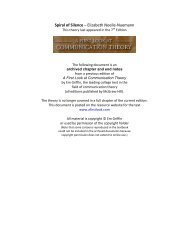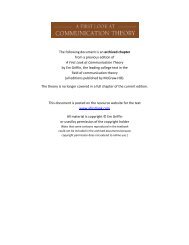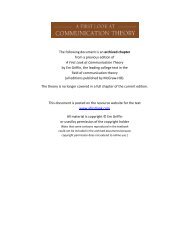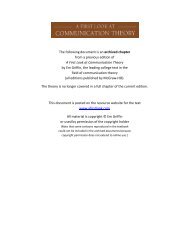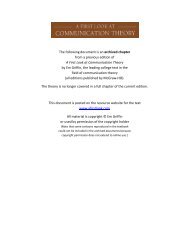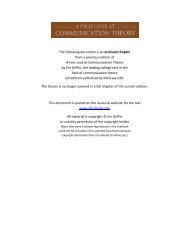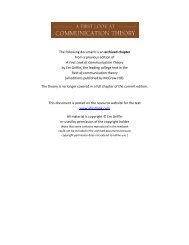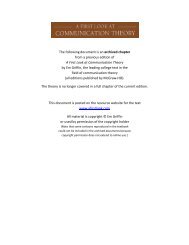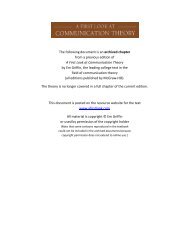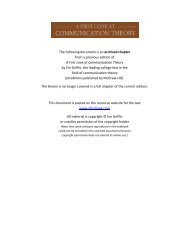Adaptive Structuration Theory of Marshall Scott Poole
Adaptive Structuration Theory of Marshall Scott Poole
Adaptive Structuration Theory of Marshall Scott Poole
Create successful ePaper yourself
Turn your PDF publications into a flip-book with our unique Google optimized e-Paper software.
CHAPTER 18: ADAPTIVE STRLTCTLTRATION THEORY<br />
245<br />
to act assertively. But this s<strong>of</strong>t critical edge seems tame for a theory so deeply rooted<br />
in the ideas <strong>of</strong> Giddens, a leading figure in the critical tradition.<br />
Ken Chase, a colleague at Wheaton, puts much <strong>of</strong> the responsibility on Giddens.<br />
Chase claims that the mark <strong>of</strong> a good critical theorist is that he or she<br />
"avoids separating ethical responsibility from theory construction and, accordingly,<br />
provides theory with an internal standard for moral argument.,,30 Although<br />
structuration theory takes communication seriously and claims that morality is<br />
an issue in all interactions, Giddens doesn't provide a moral compass that indicates<br />
a clear ethical direction. Other critical theorists featured later in the book<br />
<strong>of</strong>fer critiques grounded in the ethical assumptions <strong>of</strong> their theories (see Chapters<br />
20, 26, 34, 35). They leave no doubt about what kinds <strong>of</strong> communication they are<br />
for, and what they're against.<br />
<strong>Poole</strong>'s faithful adaptation <strong>of</strong> Giddens' ideas and terminology has another<br />
drawback. The complexity <strong>of</strong> Giddens' thinking overwhelms most readers, and<br />
his ideas are couched in a prose style that even his admirers describe as dense,<br />
thick, unforgiving, and impenetrable. <strong>Poole</strong>'s writing is much more accessible, yet<br />
Giddens' heaviness still comes through. Ironically, <strong>Poole</strong> reports that Giddens<br />
doesn't recognize his ideas when they're applied in a microanalysis <strong>of</strong> smallgroup<br />
structuration. Apparently, the British sociologist pictures sedimented<br />
structures being built across an entire society over decades, rather than layers <strong>of</strong><br />
rules and resources forming within a group after a few meetings.<br />
<strong>Poole</strong> acknowledges that structuration is a tough concept to grasp and apply.<br />
He critiques all group communication theories- his own included- for <strong>of</strong>ten<br />
failing to capture the imagination <strong>of</strong> students and practitioners:<br />
We have not intrigued, puzzled, or spoken to most people's condition. I fear we<br />
have overemphasized technique and propositional soundness at the expense <strong>of</strong> creativity.<br />
Creativity and a certain element <strong>of</strong> playfulness are just as important as<br />
sound theory construction. 31<br />
<strong>Adaptive</strong> structuration theory may not be playful, but it holds out the satisfying<br />
promise that every group member can be a player in the process <strong>of</strong> what the group<br />
creates. Some readers might wish that <strong>Poole</strong> had never abandoned the simple fivestep<br />
path <strong>of</strong> group decision making. That route is certainly less complex than the<br />
sedimented, rock-strewn landscape <strong>of</strong> structuration that <strong>Poole</strong> describes. Yet it makes<br />
no sense to stick with a simplistic theory when the actual dynamics <strong>of</strong> group life have<br />
proved to be quite complicated and rather unpredictable, probably because people<br />
are that way. <strong>Poole</strong> has therefore chosen to craft a theory <strong>of</strong> commensurate complexity.<br />
I for one would prefer he tell it like it is rather than try to dumb it down.<br />
QUESTIONS TO SHARPEN YOUR FOCUS<br />
1. <strong>Poole</strong> refers to group communication as action rather than behavior. How does<br />
his choice <strong>of</strong> words reflect a rejection <strong>of</strong> the phase or single-sequence model <strong>of</strong> group<br />
decision making?<br />
2. <strong>Poole</strong> and Giddens regard duality <strong>of</strong> structure as the key to understanding structuration.<br />
How does the Dilbert cartoon on page 243 illustrate this crucial concept?<br />
3. Suppose you've been elected by communication majors to represent student<br />
opinion to department faculty. In what way is your role both a rule and a resource?<br />
How could you produce and/ or reproduce student influence?



